Ticks are commonly confused with bed bugs.
That’s no surprise as both are small and feed on blood to survive.
Nonetheless, correctly identifying these two pests is vital to terminate them.
In this article, we’ll go over all the differences between ticks and bed bugs.
Let’s dive in.
Ticks vs. Bed Bugs: Appearance
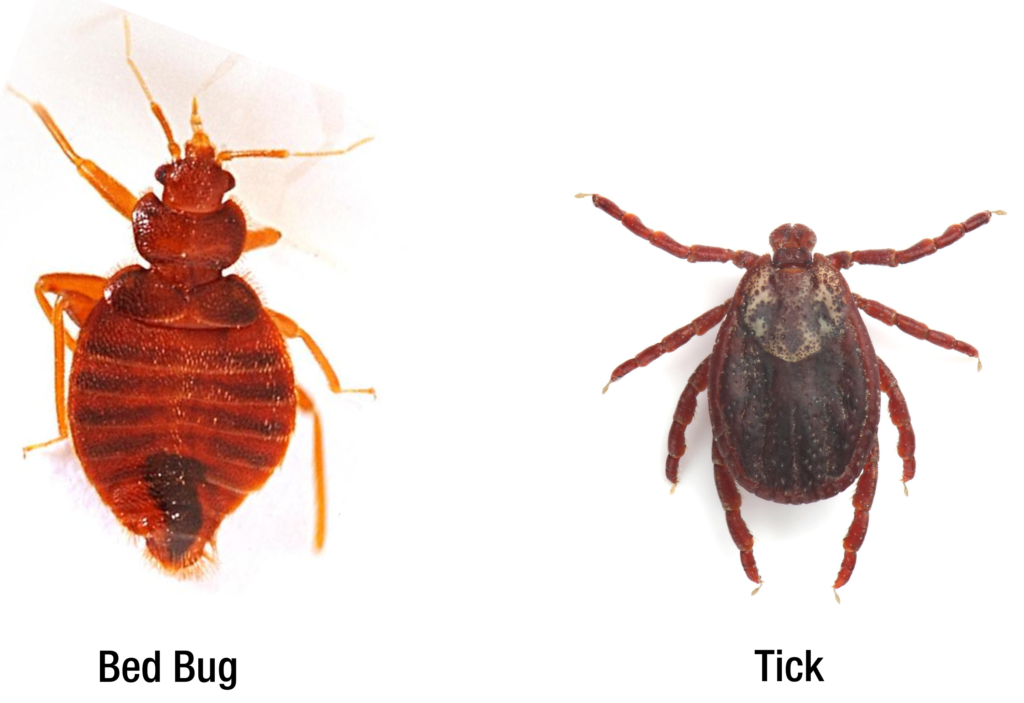
- Adult bed bugs are 3/16” or around 4 to 5mm. They can be compared to the size of a short grain of rice. Adult ticks can range in size from 5mm to 15mm. They are much larger when engorged, reaching sizes of 15mm.
- Bed bugs have colors ranging from light brown to dark brown. Depending on the tick species, their color can vary from light brown to dark red or black. When engorged, ticks become darker and take on a reddish black color.
- Bed bugs have six legs with two forward-facing and facing four backward. Ticks have eight legs with four forward-facing and four facing backward.
- Bed bugs have two antennas positioned diagonally from their head. In contrast, ticks do not have antennas.
- Both bed bugs and tick have an oval-shaped body.
- Bud bugs remain flat unless they have a blood meal. In which case, they become more round.
- Both bed bugs and ticks do not have wings and cannot fly.
Bed Bug vs. Ticks: Distribution
In What Region Do Bed Bugs Live?
Bed bugs are found in all 50 states in the U.S.
Infestations are particularly common in large cities where houses are close together.
Bed bugs are also commonly found in apartments, public transportation, schools, nursing homes, and retail stores.
In What Region Do Ticks Live?
Ticks can be found across the United States, including Alaska and Hawaii.
Since ticks die during the winter months, they are only active in certain states during certain months.
Bed Bug vs. Ticks: Habitat
Where Do Bed Bugs Live?
Bed bugs feed on humans and prefer to live near their host.
They typically aggregate in cracks, seams, folds in fabric, and small crevices.
Bed bugs flourish in places where humans stay for long periods.
These pests take harbor in mattresses, box springs, headboards, nightstands, pillows, upholstery, and other furniture.
In severe infestations, they can live on walls, wood furniture, ceilings, and even baseboards.
Where Do Ticks Live?
Ticks are quite versatile in their habitat.
They can find them both outdoors and indoors.
Outdoor harborage:
- Fallen branches
- Tall brush
- Grassy areas
- Near wood or wooden areas
- Bird feeders
- Leaf piles and litter
- Along walls and fences
- Near moisture
- Near trash cans
Indoor harborage:
- Carpet
- Bedrooms
- Dog Kennels
- Cat Toys
- Pets
- Mattresses
- Blankets
- Dirty laundry
Bed Bugs vs. Ticks: Diet
What Do Bed Bugs Eat?
Bed bugs drink blood to survive.
They commonly feed on humans but will resort to warm-blooded mammals such as dogs, cats, birds, and rodents if humans are not around.
What Do Ticks Eat?
Similar to bed bugs, ticks drink blood to survive.
Adult ticks can survive between one and two years without a host.
Larvae and nymphs can only survive 1-2 weeks without a host before dying.
Bed Bugs vs. Ticks: Bites
Do Bed Bugs Bite?
Yes. Bed bugs bite humans to feed on blood.
When bed bugs bite you, they administer an anesthetic to make it painless. This method allows them to suck your blood without you noticing.
They also release anticoagulants so they can feed on your blood as efficiently as possible.
Once bed bugs finished feeding, they return to their harborage until they need to feed again.
But while bed bug bites are not painful at first, they can eventually become swollen and irritated.
Bed bug bites look like welts and do not have a red spot at the center, unlike other insect bites such as spiders and fleas.
Bed bugs will bite you anywhere there is exposed skin.
Common locations for bed bites include:
- Arms
- Legs
- Ankles
- Back
- Torso
- Neck
- Feet
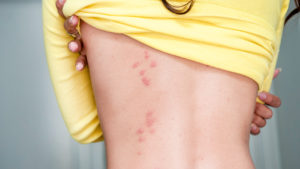
Do Ticks Bite?
Yes. Ticks bite to extract and feed on blood. Their bites are usually painless and don’t itch at all.
Unlike bed bugs, ticks stay attached to their host for several days before they release their grip.
Tick bites typically leave red welts on the skin with some residual redness around the bite mark.
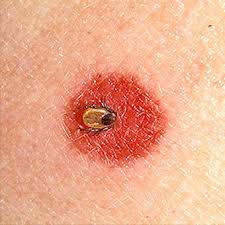
Bed Bugs vs. Ticks: Flight
Do Bed Bugs Fly?
While adult bed bugs develop wing pads, they do not fly.
These wing pads do not develop into fully functional wings and have no practical use.
Do Ticks Fly?
Ticks do not fly or jump. They crawl to attach themselves to people or pets.
Once attached, they crawl up and find somewhere to impale themselves onto their host.
Bed Bugs vs.Ticks: Dangers
Are Bed Bugs Harmful?
Bed bugs do not carry any diseases and are relatively harmless compared to other pests such as mosquitoes and cockroaches.
Having a bed bug infestation can be disruptive to the well being of their human host.
Most people that have infestation suffer from anxiety and lack of sleep.
Bed bug bites can be extremely bothersome, especially for young children.
They can cause excessive scratching, leading to skin infections.
Bed bug bites also cause allergic reactions, and in severe cases, they may need medical attention.
Finally, their bites can transmit parasites, although it’s not common.
Are Ticks harmful?
Ticks are generally harmless. Their bites are not painful nor itchy.
That said, some species of ticks can cause diseases.
Deer and wood ticks, in particular, are known to carry germs that can cause Lyme disease and Rocky Mountain fever.
In some people, tick bites can cause an allergic reaction, which results in a rash on the skin.
Bed Bugs vs.Ticks: Baby
What Do Baby Bed Bugs Look Like?
Bed bugs go through a partial metamorphosis, which means their babies look similar to adults.
Juvenile bed bugs, or nymphs, go into five stages before becoming a full adult.
When bed bugs first hatch, they are only about 1.5 mm long. They have white, oval, and flat bodies.
The nymphs also have two antennas and six legs.
As they mature, they gradually turn from white to dark brown.
Nymphs shed their skins to grow in a process called molting. Every time they molt, they become slightly darker and bigger.
Baby bed bugs need to feed on blood to grow. If they can find enough food, they can become full adults in about six weeks.
They can grow up to 4.5mm long before shedding their exoskeleton one last time.
What Do Baby Ticks Look Like?
After hatching, baby ticks emerge as six-legged larvae.
They are typically lighter in color than adults with a color ranging from light brown or red.
Baby ticks are tiny, measuring between 0.5 and 1 mm.
They will molt twice before each adulthood.
Bed Bugs vs. Ticks: Eggs
What do Bed Bugs eggs look like?
Bed bug eggs are white.
They are about 1 mm in length, similar to the size of two grains of salt.
They are sticky and are typically in clusters inside cracks and crevices.
Bed bug eggs take about two weeks to hatch into a white baby bed bug.
Once hatched, the juvenile bed bug will leave behind its eggshell, which generally looks like white debris.
What do Tick eggs look like?
Tick eggs come in large clusters and resemble caviar.
They range in color from brownish-red in color and are translucent.
Bed Bugs vs. Tick: Lifecycle
What is the bed bug lifecycle?
Bed bugs go through seven stages of development.
The first stage is egg, followed by five different nymph stages, and finally, the adult stage.
During the nymph stages, bed bugs progressively grow larger.
Nymphs must eat at least once to reach the next phase of development.
Bed bugs eggs take around five to six weeks for bud bugs to reach adulthood.
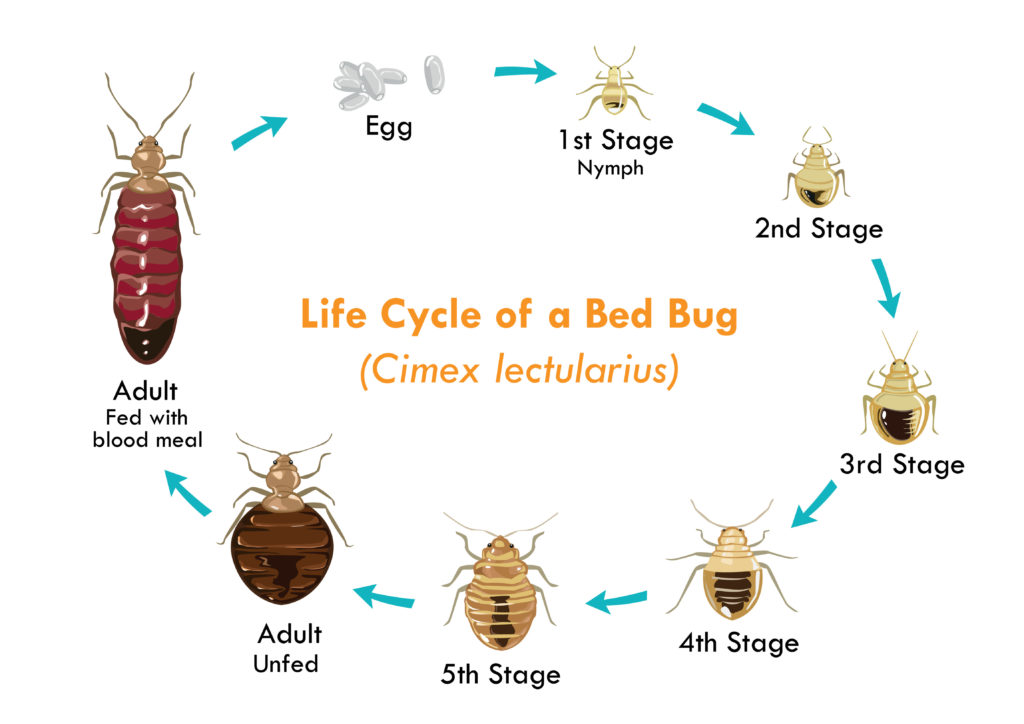
What is the Tick Life Cycle?
Ticks go through five stages of development: egg, larvae, nymph, and adult.
In most cases, it can take around three years to complete the full lifecycle, but most ticks will die due to a lack of a food source.
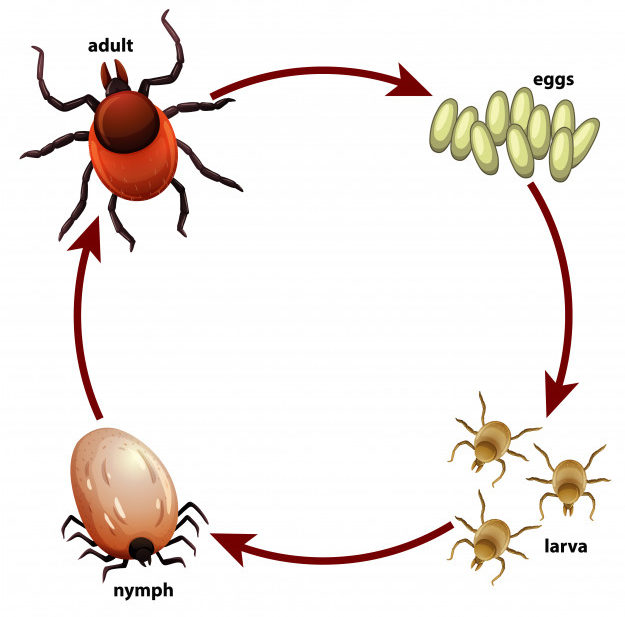
Bed Bugs vs. Ticks: Cause
What Causes Bed Bugs?
Most often, bed bug hitchhikes their way into your home from a location that already has bed bugs.
They can enter your home by attaching themselves to backpacks, luggage, clothes, grocery bags, etc.
In most cases, bed bugs don’t invade your homes from an outdoors.
Bed bugs can also enter your home through used furniture, electronics, and clothing.
These bugs can hide inside used items for up to 12-14 months without eating.
There are some reports of bed bugs walking across power lines and outdoor walls, but this is rare.
What Causes Ticks?
If you have ticks, it is likely because you came into contact with a tick outdoors.
A tick infestation can start with one single female tick entering your home. Female ticks can lay up to 1000 eggs in one day.
Ticks are common in homes with pets that go outdoors.
Dogs and cats are prime targets for ticks because they can easily attach to their paws and move their way up their body.
Bed Bugs vs. Ticks: How Common Are They?
How Common Are Bed Bugs?
A study found that 20% of Americans have either had bed bugs or know someone who has.
Bed bugs spread easily from one home to another, and clusters of infestations tend to happen.
Bed bugs are one of the most common pests in homes, especially because they do not discriminate.
They will infest any home regardless of social class, cleanliness, or state.
How Common Are Ticks?
Ticks are not a common pest issue in the US.
They are more common for those who have pets or kids.
Pets and kids act as easy targets for ticks to attach themselves to.
That’s because pets and kids tend to spend regular time outdoors near woody or grassy areas.
Bed Bugs vs. Ticks: Elimination
How To Get Rid of Bed Bugs?
There are several different methods that you can use to eliminate bed bugs.
The one you choose will depend on the severity of your infestation and budget for treatment.
Common treatments include:
- Washing, Steaming, and Vacuuming
- Heat Treatment
- Mattress Encasement
- Fumigation
- Bed Bug Traps
- Chemical Insecticide
How To Get Rid of Ticks?
To remove a tick on your skin or your pets’, use a set of tweezers to pluck it out.
Dispose of the tick into a container with water to drown it.
To eliminate large infestations, apply an insecticide to your yard.
If you have a tick indoors, the best option is to use a combination of steaming, vacuuming, and, if necessary, an abrasive powder such as diatomaceous earth.
